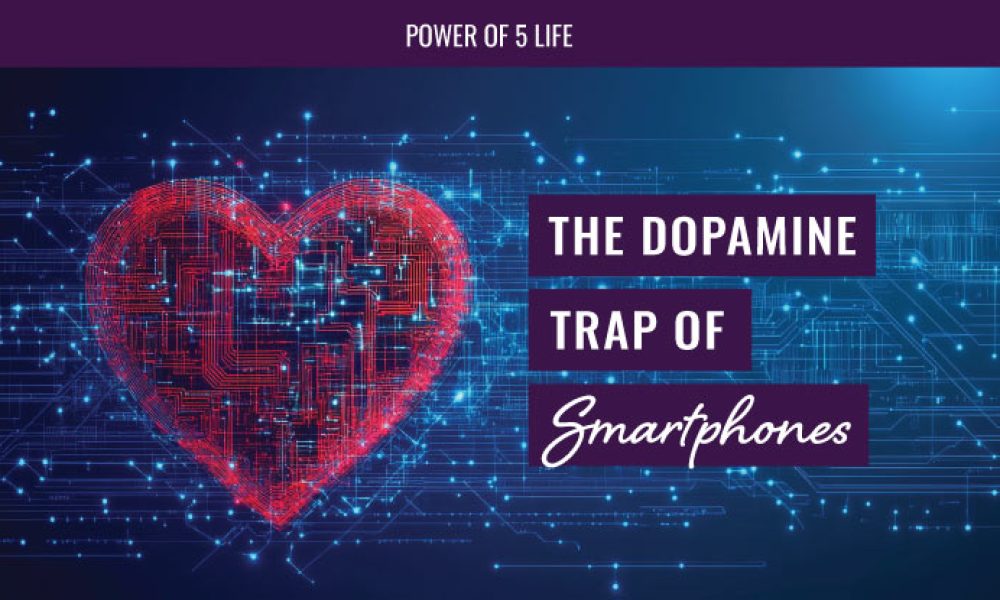Hooked on Our Phones: The Dopamine Trap of Smartphones
Let’s delve into how our brains adapt to today’s technological landscape, including powerful and potentially harmful addictive behaviors centered around our smartphones.
Always On: Understanding Smartphone Addiction
As humans, our surviving and thriving are intrinsically linked to reward. We are naturally drawn to experiences that release pleasure-inducing neurochemicals, whether it’s the satisfaction of a good meal, the connection of intimacy, or even the fleeting high from substances. It’s this very mechanism that underpins smartphone addiction.
The seemingly innocuous likes, texts, and notifications trigger the release of dopamine, the brain’s pleasure neurotransmitters, creating a pleasurable or even euphoric sensation. This chemical reward system powerfully reinforces our engagement with our phones, making the urge to check and interact incredibly difficult to resist.
This dopamine effect isn’t unique to technology. We see it at play in our attraction to sugary foods, the thrill of gambling, excessive exercise, and the satisfaction of social connection. Just as food manufacturers strategically use sugar and fat to induce dopamine release, developers of games and social media platforms have expertly leveraged this neurological pathway to keep our attention glued to our screens. This digital engagement can often come at the expense of productivity, meaningful relationships, and even essential activities like exercise or homework for children.
The Compulsive Cycle: Seeking the Next Dopamine Hit
This craving for the dopamine high fuels compulsive phone checking. The anticipation of a new message, an email, or a like becomes a conditioned response. However, the absence of these digital rewards can trigger anxiety and even feelings of rejection, further exacerbating stress. This is where FOMO (fear of missing out) often plays a significant role, constantly driving us to reach for our smartphones to avoid feeling disconnected or left behind.
The Illusion of Doing It All: The Myth of Multitasking with Technology
Another significant and stressful consequence of our tech-saturated lives is the pervasive myth of multitasking. While we may believe we’re efficiently handling multiple tasks simultaneously, our brains simply aren’t wired for true multitasking. Instead, they rapidly switch focus between tasks.
Attempting to juggle emails, social media, and other digital demands while trying to accomplish real-world tasks leads to cognitive overload. This constant mental switching creates significant stress on our brains, hindering efficiency, and ultimately contributing to feelings of overwhelm. Recognizing this pattern is the first crucial step in regaining control over our attention and reducing this self-imposed stress.
The Body’s Silent Protest: Physical Manifestations of Tech Stress
The chronic mental strain of our always-on culture and constant digital engagement often manifest physically. Increasingly common physical symptoms of tech stress include persistent headaches, digital eye strain, neck and shoulder pain stemming from poor posture while using devices, and even digestive issues. These physical ailments serve as tangible reminders of the toll our tethered existence takes on our overall well-being.
Waning Focus, Shallow Thoughts: The Limitation of Deep Work
The relentless influx of notifications and the ingrained expectation of instant communication create a state of digital overload. This severely hinders our ability to focus and engage in deep, thoughtful work. It also makes it increasingly difficult to relax, engage in meaningful meditation, or simply enjoy moments of peaceful contemplation.
Are you always on?
Are you part of the always-on culture? Have you recognized the subtle pull of the dopamine effect when your phone buzzes or pings? Has FOMO ever driven you to compulsively check your device, only to feel a pang of disappointment when there’s nothing new? As a species, our evolution hasn’t equipped us to navigate the addictive potential of modern technology. Our nervous systems are bearing the brunt, manifesting as increased stress, symptoms of depression, and feelings of isolation.
In our upcoming discussions, we will delve further into the negative impact of this tech-driven world on our relationships and the growing loneliness epidemic. We will explore practical, actionable strategies to combat the urge to constantly check our phones, break free from the dopamine trap, and re-prioritize the healthier connections that nourish our well-being. Stay tuned for those empowering insights.
What small step will you take today to prioritize your health? Share your thoughts with me at [email protected]
For more empowering insights and practical strategies to enhance your well-being, follow us on Substack! Let’s continue this journey to a healthier and happier you, together.
Don’t forget to share this post with those in your life to inspire them on their own wellness journey!
To a long and healthy life,
David Bernstein, MD
Note: In our previous discussion, we explored how the constant influx of data and notifications from our smartphones overwhelms our brains and contributes significantly to technology stress.
A human (David Bernstein) generated this blog content with the polishing aid of artificial intelligence.



